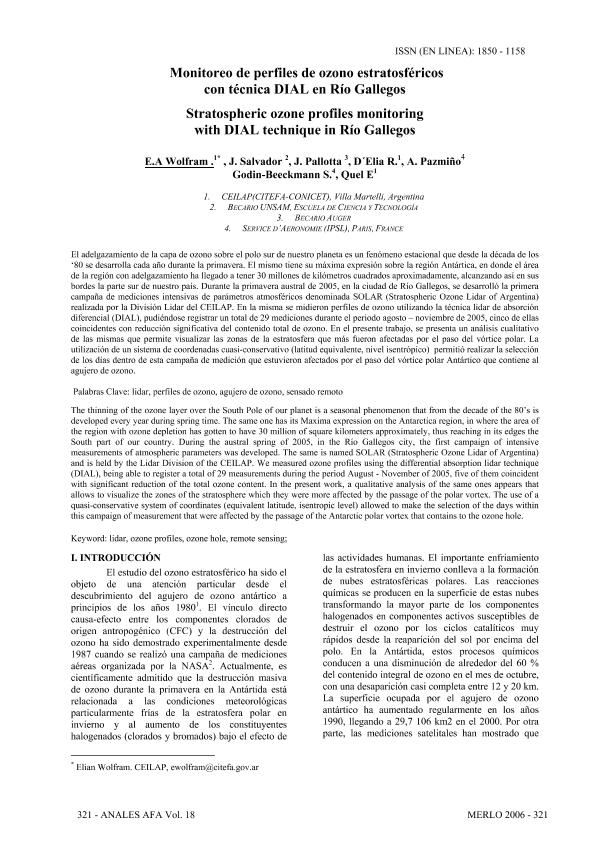Artículo
El adelgazamiento de la capa de ozono sobre el polo sur de nuestro planeta es un fenómeno estacional que desde la década de los ‘80 se desarrolla cada año durante la primavera. El mismo tiene su máxima expresión sobre la región Antártica, en donde el área de la región con adelgazamiento ha llegado a tener 30 millones de kilómetros cuadrados aproximadamente, alcanzando así en sus bordes la parte sur de nuestro país. Durante la primavera austral de 2005, en la ciudad de Río Gallegos, se desarrolló la primera campaña de mediciones intensivas de parámetros atmosféricos denominada SOLAR (Stratospheric Ozone Lidar of Argentina) realizada por la División Lidar del CEILAP. En la misma se midieron perfiles de ozono utilizando la técnica lidar de absorción diferencial (DIAL), pudiéndose registrar un total de 29 mediciones durante el periodo agosto – noviembre de 2005, cinco de ellas coincidentes con reducción significativa del contenido total de ozono. En el presente trabajo, se presenta un análisis cualitativo de las mismas que permite visualizar las zonas de la estratosfera que más fueron afectadas por el paso del vórtice polar. La utilización de un sistema de coordenadas cuasi-conservativo (latitud equivalente, nivel isentrópico) permitió realizar la selección de los días dentro de esta campaña de medición que estuvieron afectados por el paso del vórtice polar Antártico que contiene al agujero de ozono. The thinning of the ozone layer over the South Pole of our planet is a seasonal phenomenon that from the decade of the 80’s is developed every year during spring time. The same one has its Maxima expression on the Antarctica region, in where the area of the region with ozone depletion has gotten to have 30 million of square kilometers approximately, thus reaching in its edges the South part of our country. During the austral spring of 2005, in the Río Gallegos city, the first campaign of intensive measurements of atmospheric parameters was developed. The same is named SOLAR (Stratospheric Ozone Lidar of Argentina) and is held by the Lidar Division of the CEILAP. We measured ozone profiles using the differential absorption lidar technique (DIAL), being able to register a total of 29 measurements during the period August - November of 2005, five of them coincident with significant reduction of the total ozone content. In the present work, a qualitative analysis of the same ones appears that allows to visualize the zones of the stratosphere which they were more affected by the passage of the polar vortex. The use of a quasi-conservative system of coordinates (equivalent latitude, isentropic level) allowed to make the selection of the days within this campaign of measurement that were affected by the passage of the Antarctic polar vortex that contains to the ozone hole.
Monitoreo de perfiles de ozono estratosféricos con técnica DIAL en Río Gallegos
Título:
Stratospheric ozone profiles monitoring with DIAL technique in Río Gallegos
Wolfram, Elian Augusto ; Salvador, Jacobo Omar
; Salvador, Jacobo Omar ; Pallotta, Juan Vicente
; Pallotta, Juan Vicente ; D´Elia, R.; Pazmiño, A.; Godin Beeckmann, S.; Quel, Eduardo Jaime
; D´Elia, R.; Pazmiño, A.; Godin Beeckmann, S.; Quel, Eduardo Jaime
 ; Salvador, Jacobo Omar
; Salvador, Jacobo Omar ; Pallotta, Juan Vicente
; Pallotta, Juan Vicente ; D´Elia, R.; Pazmiño, A.; Godin Beeckmann, S.; Quel, Eduardo Jaime
; D´Elia, R.; Pazmiño, A.; Godin Beeckmann, S.; Quel, Eduardo Jaime
Fecha de publicación:
12/2007
Editorial:
Asociación Física Argentina
Revista:
Anales AFA
ISSN:
0327-358X
e-ISSN:
1850-1168
Idioma:
Español
Tipo de recurso:
Artículo publicado
Clasificación temática:
Resumen
Archivos asociados
Licencia
Identificadores
Colecciones
Articulos(UNIDEF)
Articulos de UNIDAD DE INVESTIGACION Y DESARROLLO ESTRATEGICOS PARA LA DEFENSA
Articulos de UNIDAD DE INVESTIGACION Y DESARROLLO ESTRATEGICOS PARA LA DEFENSA
Citación
Wolfram, Elian Augusto; Salvador, Jacobo Omar; Pallotta, Juan Vicente; D´Elia, R.; Pazmiño, A.; et al.; Monitoreo de perfiles de ozono estratosféricos con técnica DIAL en Río Gallegos; Asociación Física Argentina; Anales AFA; 18; 1; 12-2007; 321-326
Compartir



